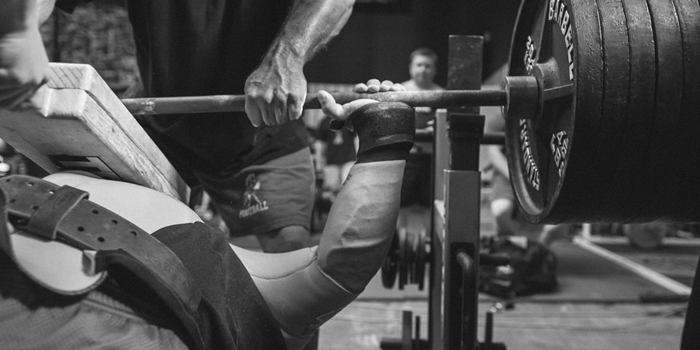
To some people, the idea of removing dynamic work from a conjugate program is blasphemy. However, you only have to listen to the Westside podcasts, to seasoned conjugate lifters, or even read the book of methods to see that speed isn't always what's needed.
As previously written about by Matt Ladewski called "Six Off-Season Bench Cycles to Replace Dynamic Effort Work," we can see that there are times where other style cycles are used, either after a meet or just for a break from traditional dynamic work.
RECENT: Conjugate for General Population Personal Training
I developed this protocol initially for a junior female lifter who was struggling to hit her potential on the lift. As a 48kg lifter and relatively new to the sport, there were several things I was hoping to improve in the non-competitive season of training. This protocol has resulted in personal bests in both raw and equipped max lifts for the athlete in question and is showing improvements already in several of my other clients. Although a small pool of athletes to monitor, there seems to be, on average, around a five to seven percent increase in 1RM bench by the end of phase two, with a further increase after phase three, since implementing this as a part of their programming.
Areas of Improvement
Areas this protocol was implemented to aid and develop were:
- Develop pressing musculature
- Improve position-specific strength endurance
- Address specific area weakness
- Improve lockout and tricep strength
- Work the strength curve
The Protocol
Westside Barbell and many others have implemented 6x6, 8x8, and even 10x10 protocols as dynamic bench press replacements previously, meaning that this is nothing new. Through observation, I recognized that the biggest improvements in the majority of my athletes came from the 6x6 phases, where we increased intensity (weight) each week until failure. This makes sense as we already know adaptation only occurs at or near fatigue. That being said don't be tempted to start your weights too high as we wish to develop and maintain proficient techniques. As I have referenced in previous writings, it takes longer to retrain a faulty pattern than maintain a correct one. My athletes' successes at specific times made me realize maybe there was a way to capitalize on the success each 6x6 block gave, and that's when I decided to design their programs to run them back to back with different variations. Each variation built on the last.
Protocol Breakdown
- Start around 55-60 percent of 1RM bench on all stages, 65 percent at the maximum, and only if you feel that they have improved drastically
- No matter which stage, always start over at the beginning
- Complete six sets of six reps each week at working weight
- Increase each week by a small amount (around 1.25kg/2.5lb a side on average)
- The amount does not have to be standardized and can change each week, but it must be small
- You may go as small as 1kg or 2lb jumps total for lighter/smaller athletes
- If you fail, you may try the next week again, only if you feel it was due to external factors. Be honest with yourself
- Failure should occur once technique is no longer proficient. Grinding is okay, but your form should not be compromised entirely
- Once you have failed, move on to the next phase. Choose an exercise and start over
- You must run the phases in order.
Phase One — The Groundwork
In this phase, we have two options to choose from, which will be used to develop the pressing musculature from a weakened position generally. Dependent on leverages, select the option which is either least favored or weaker. With the floor press, I would like to see a pause at the bottom as I treat this as an upper-body box squat with my clients building static to dynamic strength.
Options
- The Barbell Floor Press
- The Larson Press
Phase Two — Specific Bench Practice
Now that we have failed in the first phase, we now start over on phase two with the same or slightly elevated start weight from phase one.
We look here to work on developing a competitive bench setup, starting as always at a moderate intensity and building up. The upper back muscles, in particular, I find most athletes struggle to maintain position, including myself. It's a common thing I see in both beginner and intermediate lifters, too. As the weight increases over the weeks, the time to complete the set will likely increase, along with the demands on positional muscles—much like a max lift where force (F) may take some time to create.
I won't go into what constitutes the best bench setup here; however, there are some great videos in the "So you think you can bench" collection, which lay an amazing foundation.
Again, there are two options here. The first option is the competition style (my favorite); however, I am a huge fan of protecting the shoulders. If a one-board aids in this for yourself or your athlete, then choose that option.
Options
- Competition Style/Wide Bench Press
- Competition Style 1-Board Bench
Phase Three — The Extra Mile
After pushing phase two to its limit, we once again look to change the movement and push one last time! Hopefully, and very likely, your failed weight on phase two was equal to or greater than your failed weight in phase one.
Below are several options for this stage with a description of why this variation holds value. Choose wisely as we are looking to develop the main weakness holding you back from gaining more success in the bench press!
Options
Bench Press into Chain
- Increased resistance following strength curve
- Great for triceps weakness or equipped lifters
- Can sometimes be kinder on elbows than bands
Bench Press into Doubled elitefts Mini Bands
- Increased resistance following strength curve
- Increased eccentric speed
- Again, suitable for equipped or those in need of lockout development
- The additional variation of resistance from the band has been proven to be a proficient method of increasing 1RM lifts
- For smaller lifters, please take into account the possible need to modify the amount of accommodating resistance
Cambered Squat Bar Bench
- Highly/Moderately unstable depending on the bar, so it's great for those developing stability
- Will cause greater awareness of eccentric and concentric pressing movement
- Increased intermuscular coordination caused by unstable load
Discussion
This is not the only way this template could be used. It's also not the be-all protocol for replacing dynamic bench press waves in a conjugate program. It's a specific system I have put in place for my clients and athletes. When all three phases are complete, on average, I found a 10-15 percent increase in the 1RM as part of the system in my beginner and intermediate lifters, along with a 15 percent increase in 1RM for my junior (now open) lifter's equipped max. I believe, however, it will have a great value to late beginner and intermediate level lifters who like my athletes required the ability to hold the bench position for a lengthened time or who fail to maintain it when intensity is close to 1RM.
For those that give this protocol a try during their next non-competitive season, I wish you good fortune and look forward to seeing your bench press increase.
References
- Bellar, David M, et al. "The Effects of Combined Elastic- and Free-Weight Tension vs. Free-Weight Tension on One-Repetition Maximum Strength in the Bench Press." Journal of Strength and Conditioning Research, vol. 25, no. 2, 2011, pp. 459–463., doi:10.1519/jsc.0b013e3181c1f8b6.
- Dunnick, Dustin D., et al. "Bench Press Upper-Body Muscle Activation Between Stable and Unstable Loads." Journal of Strength and Conditioning Research, vol. 29, no. 12, 2015, pp. 3279–3283., doi:10.1519/jsc.0000000000001198.
- Ladewski, Matt. "Six Off-Season Bench Cycles to Replace Dynamic Effort Work." Elitefts, www.elitefts.com/education/six-off-season-bench-cycles-to-replace-dynamic-effort-work/.
- Lawrence, Michael A., and Lara A. Carlson. "Effects of an Unstable Load on Force and Muscle Activation During a Parallel Back Squat." Journal of Strength and Conditioning Research, vol. 29, no. 10, 2015, pp. 2949–2953., doi:10.1519/jsc.0000000000000955.
- Mccurdy, Kevin, et al. "Comparison of Chain- and Plate-Loaded Bench Press Training on Strength, Joint Pain, and Muscle Soreness in Division II Baseball Players." Journal of Strength and Conditioning Research, vol. 23, no. 1, 2009, pp. 187–195., doi:10.1519/jsc.0b013e31818892b5.
- Motor Learning and Performance a Situation-Based Learning Approach / by Richard A. Schmidt...et Al. Human Kinetics, 2008.
- Ostrowski, Stephanie J., et al. "Effect of an Unstable Load on Primary and Stabilizing Muscles During the Bench Press." Journal of Strength and Conditioning Research, vol. 31, no. 2, 2017, pp. 430–434., doi:10.1519/jsc.0000000000001497.
- Simmons, Louie. Westside Barbell Book of Methods. Westside Barbell, 2007.
- Zatsiorsky, Vladimir M., et al. Science and Practice of Strength Training. Human Kinetics, 2021.
Luke Litchfield is from South Wales, U.K., and is a former international junior athlete in track and field and is currently a BPU British Champion powerlifter competing in single-ply. He graduated with first-class honors in sport and exercise science from the University of South Wales. He's putting his knowledge to use as a self-employed physical therapist. When he's not working or training, Luke can be found with his family.











2 Comments